Open Educational Resources (OER)
- Open Education at UWM
- Introduction to OER
- Open Textbooks
- OER Search
- Open Images & Videos
- Creative Commons Attribution
- OER Science Content
- OER Performing Arts Content
- OER Humanities Content
- OER Health Sciences Content
- Remixing OER
- Writing and Editing OER in Pressbooks
- Workshop: Student Curation & OER: A World Languages Model
Guides and Tools
-
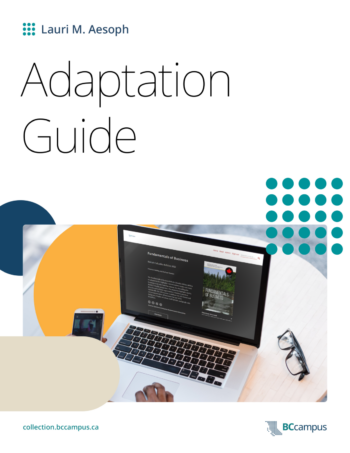 Adaptation Guide
by
Lauri M. Aesoph
Publication Date: March 29, 2016A reference for adapting or revising an open textbook
Adaptation Guide
by
Lauri M. Aesoph
Publication Date: March 29, 2016A reference for adapting or revising an open textbook -
 A Guide to Making Open Textbooks with Students
by
Ed. Elizabeth Mays
ISBN: 978-1-989014-03-5Publication Date: August 29, 2017A handbook for faculty interested in practicing open pedagogy by involving students in the making of open textbooks, ancillary materials, or other Open Educational Resources.
A Guide to Making Open Textbooks with Students
by
Ed. Elizabeth Mays
ISBN: 978-1-989014-03-5Publication Date: August 29, 2017A handbook for faculty interested in practicing open pedagogy by involving students in the making of open textbooks, ancillary materials, or other Open Educational Resources. -
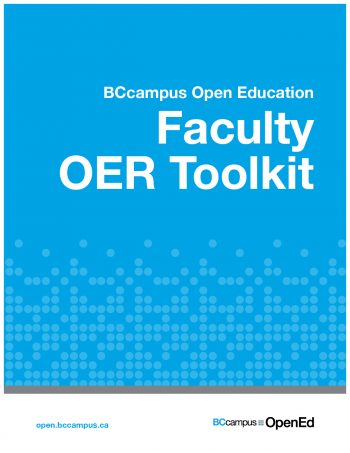 Faculty OER Toolkit
by
Shannon Moist
ISBN: 978-1-77420-044-5Publication Date: March 8, 2017The Faculty OER Toolkit is an information resource about and guide to adapting and adopting Open Educational Resources. Included are definitions and examples, information about Creative Commons licensing, and tips on how to adapt and/or adopt OER for classroom use.
Faculty OER Toolkit
by
Shannon Moist
ISBN: 978-1-77420-044-5Publication Date: March 8, 2017The Faculty OER Toolkit is an information resource about and guide to adapting and adopting Open Educational Resources. Included are definitions and examples, information about Creative Commons licensing, and tips on how to adapt and/or adopt OER for classroom use.
-
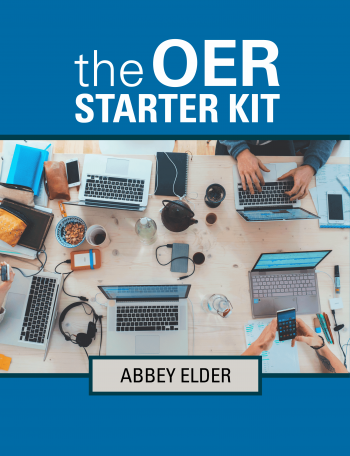 The OER Starter Kit
by
Abbey Elder
Publication Date: August 13, 2021Review this chapter on Centering Diversity and Inclusion for a thoughtful perspective on your can examine your cultural and class-based perspectives and their impact on your course materials.
The OER Starter Kit
by
Abbey Elder
Publication Date: August 13, 2021Review this chapter on Centering Diversity and Inclusion for a thoughtful perspective on your can examine your cultural and class-based perspectives and their impact on your course materials.
-
OpenStax Development GuidelinesOpenStax provides guidance on representation and diversity in their development guidelines.
-
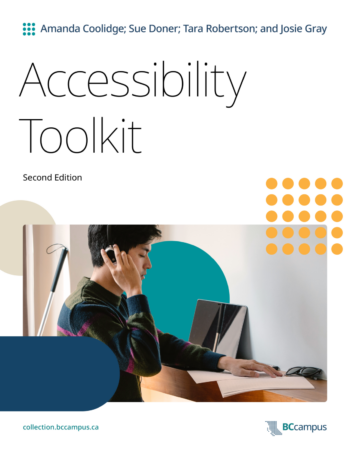 BCcampus Open Education Accessibility Toolkit 2nd Edition
by
Amanda Coolidge, Sue Doner, Tara Robertson, and Josie Grey
Publication Date: August 31, 2018The goal of the Accessibility Toolkit - 2nd Edition is to provide resources for each content creator, instructional designer, educational technologist, librarian, administrator, and teaching assistant to create a truly open textbook—one that is free and accessible for all students. This is a collaboration between BCcampus, Camosun College, and CAPER-BC.
BCcampus Open Education Accessibility Toolkit 2nd Edition
by
Amanda Coolidge, Sue Doner, Tara Robertson, and Josie Grey
Publication Date: August 31, 2018The goal of the Accessibility Toolkit - 2nd Edition is to provide resources for each content creator, instructional designer, educational technologist, librarian, administrator, and teaching assistant to create a truly open textbook—one that is free and accessible for all students. This is a collaboration between BCcampus, Camosun College, and CAPER-BC. -
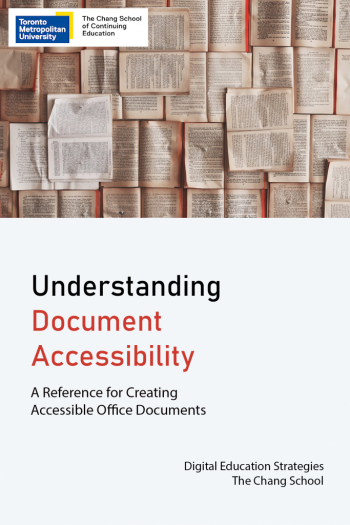 Understanding Document Accessibility Subtitle: A Reference for Creating Accessible Office Documents
by
Digital Education Strategies, The Chang School
Publication Date: January 15, 2020With much of the world gone digital, learning to create documents that are accessible to everyone is becoming a necessary skill. Intended for a general audience, this free resource reviews a wide range of document authoring applications, including the tools they contain for creating accessible documents, and tests them to ensure they do not contain potential barriers.
Understanding Document Accessibility Subtitle: A Reference for Creating Accessible Office Documents
by
Digital Education Strategies, The Chang School
Publication Date: January 15, 2020With much of the world gone digital, learning to create documents that are accessible to everyone is becoming a necessary skill. Intended for a general audience, this free resource reviews a wide range of document authoring applications, including the tools they contain for creating accessible documents, and tests them to ensure they do not contain potential barriers.
-
CUNY Accessibility Toolkit for Open Education ResourcesThis LibGuide, compiled by staff at the City University of New York, gives tips on creating accessible content, evaluates OER platforms, gives creators guidance on evaluating their own OER sites and addresses accessibility best practices.
-
Accessibility and Open Educational ResourcesThis resource provides resources about the accessibility of OER and Universal Design for Learning. This includes information about OER, a list of accessibility requirements for educational materials, and rubrics for assessing an OER's accessibility.
What content can I use in an OER remix?
Remixes can include materials with open licenses, materials under Fair Use, materials in the public domain, and original content. Understanding how these items can work together will give open education creators the most possible elements to create their resources.

Difference between open license, public domain and all rights reserved copyright by Boyoung Chae is licensed under CC-BY 4.0.

Licenses by Longwood University Library. CC-BY 4.0
The term “public domain” includes those materials that are not protected by intellectual property laws such as copyright, trademark, or patent laws. No individual owns these works; rather, they are owned by the public. Anyone can use a public domain work without obtaining permission and without citing the original author, though it's good practice to cite the original author whenever possible.
Fair Use, covered under U.S Copyright Code,17 § 107, allows for people to use copyrighted content with requiring permission. Educational use is specifically listed as one of these acceptable circumstances, though users need to balance four factors:1) the purpose and character of the use, 2) the nature of the copyrighted work, 3) the amount and substantiality of the portion of the work in relation to the whole, and 4) the effect of the use upon the potential market.
Additional Resources
Where do I find content to remix?
-
Open Textbook LibraryOpen Textbook Library at University of Minnesota. Includes reviews.
-
OpenStaxOpenStax from Rice University offers free, online educational materials and textbooks, some of which can be printed at an affordable price.
-
BCcampus Open EdAn open textbook project based out of British Colombia. Many books have been reviewed by faculty.
-
Saylor AcademyOpen textbooks from the Saylor Academy.
-
American Institute of MathematicsOpen textbooks that have been approved by the American Institute of Mathematics.
-
InTechOpen Access textbooks and journals with a focus on the sciences.
-
MIT Open CoursewareLinks to open textbooks on a variety of topics from the Massachusetts Institute of Technology.
Open Education Resources are more than just textbooks. They include curriculum maps, course materials, textbooks, streaming videos, multimedia applications, podcasts, and any other materials that have been designed for use in teaching and learning. You can access simulations, labs, and illustrations that can be reused in slides, handbooks, and other materials. Other repositories have lesson plans, quiz banks, worksheets and slide presentations.
Visit the OER Science Content and OER Humanities Content pages for ideas and additional resources.

Openly Available Sources Integrated Search (OASIS) is a meta-search tool for open educational resources including textbooks, podcasts, simulations, videos and other supplemental learning activities.
The Mason OER Metafinder helps you find Open Educational Resources. OER Metafinder launches a real-time, simultaneous search across 21 different sources of open educational materials as you hit the Search button. A distinct feature of the Mason OER Metafinder is the scope of our discovery service. We’re searching well-known OER repositories like OpenStax, OER Commons, MERLOT but also sites like HathiTrust, DPLA, Internet Archive and NYPL Digital Collections where valuable but often overlooked yet often “open” educational materials may be found.
Additionally the OER Metafinder allows user to do a deeper websearch. The numerous and varied results makes the Mason OER Metafinder and ideal search tool for Performing Arts and Humanities courses.
-
MerlotMerlot is a repository of peer reviewed, open access, teaching and learning materials.
-
WiscOnline"Wisc-Online is a repository of high-quality educational learning materials FREE to learners and educators.Wisc-Online offers an ever-growing library of learning objects freely available to students and learners at any level."
-
LibreTextsEach subject area in LibreTexts contains a mix of content such as texts, homework exercises, interactive applications, visualizations and simulations, laboratory experiments, and worksheets. Although the resource still leans toward the physical sciences, it also carries materials for humanities, mathematics and statistics.
Resources like Google Image Search, Youtube, and Flicker all have ways to search for resources using open licenses.
YouTube + Filter for Creative Commons

Google Image Search + Usage Rights

Flickr CC Licensed images

- Last Updated: Jun 10, 2025 12:03 PM
- URL: https://guides.library.uwm.edu/oers
- Print Page
